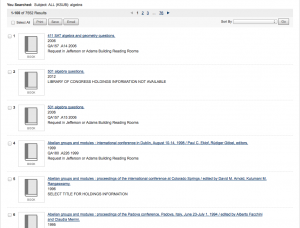When I first considered writing this up, my first thought was that it wasn’t related to cataloging. But really, like many of my projects, it actually is. I am all about the information organization and having good metadata no matter what I am doing. So here it is.
Recently, I ran out of space on my ancient iMac’s 500 GB hard drive. I have thinking for quite awhile now about shifting my media off the internal hard drive and onto an external drive array of some kind; specifically so I could add more media. Fortunately, we had a Drobo sitting around begging to be used. Now I have 2 TBs of space that is expandable to 8 TBs! All that space! Let the ripping, er, archiving commence!
First question: What format should I use?
Being firmly planted in the Apple camp, of course I use iTunes as my media player, so I need to have my music in a format that it can use. I have ripped music to mp3s previously and I know that there is a newer format that iTunes uses as the default for purchased music. But I also vaguely know that these are not “perfect” versions, that they are compressed to save space, etc. So what about an “archival” version? Is is possible to rip an exact duplicate of the CD version of the music?
I discovered that there are basically three types of music files: uncompressed; lossless, compressed; and lossy, compressed. The uncompressed files take up huge amounts of space but are exact replicas of the original CD. I guess this would be the ultimate “preservation” file, assuming I had the disk space for it. A lossless, compressed file also exactly replicates the original CD though, so I think this is probably a better choice for me. Someone else might have some sort of specific reason to choose uncompressed. The lossy, compressed file seems to be a good choice for the “access” version of the music.
My research revealed two main types of uncompressed formats: WAVE and AIFF. WAVE (Waveform Audio File Format) is used primarily by Windows computers and AIFF (Audio Interchange File Format) by Macs. I didn’t investigate these formats any further as my focus was on the lossless, compressed file types.
The Wikipedia article “Audio file format” discusses several lossless, compressed formats and further searches narrowed my interest down to two: FLAC and ALAC. FLAC stands for “Free Lossless Audio Codec” and ALAC stands for “Apple Lossless Audio Codec”. I’ll cover these in more detail below.
Finally, there are many lossy, compressed formats, but again I quickly narrowed my interest down to two: mp3 and AAC. These also I did not pursue very far in my research. Despite being the defacto standard for digital music, it turns out that the mp3 format is actually encumbered with a jumble of licensing issues. However, the adoption rate for this file format is high enough that, not being a developer, the messy licensing would probably never be an issue for me. AAC is the format that iTunes uses for music downloaded through its store. Additionally, I learned that iTunes saves AAC DRM’d files as m4p and AAC unprotected files as m4a; and as an iTunes Match subscriber, I can get my (handful) of m4p songs updated to m4a.
As an aside to this discussion about “which format?”, I learned that file format (i.e. container) and codec are not necessarily the same thing. Often a codec uses a particular file format but that is not always true. For example, FLAC can be encoded in its native container (with a file extension of .flac) or in the Ogg container (with file extension .oga).
FLAC is open-source and supported by a range of software and hardware. Everyone on the internet, (by which I mean the posters in the audiophile forums that my search results turned up[1]), seems to have generally positive things to say about FLAC. Alas, it is not supported by iTunes. But that is okay; at this point in my research, my thought was that I could use this as my “preservation” format and transcode the files into a lossy “access” format (for the smaller file size) that iTunes can use.
The objections around ALAC seem to center mainly on it being proprietary (and/or because it’s Apple) and the fact that it won’t transcode 24 bit files back out of ALAC again[2]. It turns out that while the codec was originally proprietary, Apple released it as open source in 2011. So that is now a non-issue. As for the 24 bit transcoding problem; according to Wikipedia, audio CDs are 16 bit, while audio DVDs can be up to 24 bit. I am only ripping CDs at this point, so the 24 bit transcoding problem seems like a non-issue for me. Obviously, if I should want to rip audio DVDs in the future, I would need to revisit this issue and do some more research (DRM is also an issue for audio DVDs). For 16 bit files, the audiophile forums discussing the topic assert that there is no difference in the quality of files produced by ALAC versus FLAC.
In sum, I found that FLAC is supported in more places than ALAC, but ALAC is supported by Apple. Using ALAC would also allow me to rip the music into just the one lossless format, instead of needing separate preservation and access formats.
Question: Would using ALAC lock me into iTunes as my only alternative?
More research revealed that there are several tools for converting between ALAC and FLAC. ffmpeg was the most commonly mentioned (also, free!), but others I saw frequently mentioned were dBpowerAMP and XLD.
Question: What about the metadata?
This took a bit more careful searching (and some reading between the lines) to discover the answer. The metadata was not really explicitly discussed very often. I think that “everyone knows how it works” so it is not really discussed, or people just jump right in and try it out, so they don’t ever need to ask (or they don’t care?). In any case, the sense that I got from the discussion boards was that, yes, the metadata is transcoded along with the rest.
However, there seems to be an issue with album covers. This isn’t really an issue for me as I have never made any effort to include them, but it is something to be aware of. It is not really clear to me, but I think that if the art is embedded in the metadata (requiring some effort on the part of the user), it will be transferred. But, if the art is only linked to the metadata, then it will not be transferred. I believe that iTunes’ default is to link rather than embed. I have not researched how or if it is possible to change linked art to embedded art within iTunes.
Conclusion
So the answer is fairly simple for me: use iTunes to rip my CDs into ALAC. I’ll have a lossless, compressed file that works just fine with iTunes and can be transcoded fairly easily to another format at a later date without any loss of fidelity. The next step is the hard one – actually doing it!
A note about my research process (because I care about that sort of thing)
I did all of my research on the internet. From a general internet search, I started with Wikipedia articles. These gave me the basic keywords and understanding that I needed to ask more specific questions. The answers to those questions, I found on blogs and message forums, and in the documentation for the software/codecs/file types. This was a fairly straight-forward question that I basically spent an afternoon researching. Writing this blog post, on the other hand, has taken at least four times as long. Organizing a coherent explanation that cites all of the appropriate sources apparently takes me much longer than just making a decision based on those sources.
Notes
[1] In researching differences between FLAC and ALAC, I found several forums that discuss it.
Head-Fi Forums
Hydrogenaudio Forums
Linn Forums
[2] This discussion on the Stereophile Forums specifically addresses the 16 versus 24 bit issue.


